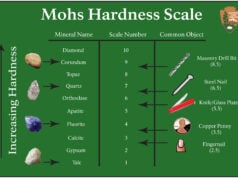The Moon, Earth’s only natural satellite, has captivated human fascination for centuries and plays a crucial role in shaping our planet’s dynamics.

Characteristics of the Moon:
- Size and Distance: The Moon is about 1/6th the size of Earth, with a diameter of approximately 3,474 kilometers. It orbits Earth at an average distance of about 384,400 kilometers.
- Gravity: Lunar gravity is much weaker than Earth’s, about 1/6th of our planet’s gravity. This property has interesting implications for human exploration and potential future lunar colonies.
- Surface Features: The Moon’s surface is marked by various features, including impact craters, mountains, valleys, and lunar maria (large, dark plains formed by ancient volcanic activity).
- Rotation and Orbit: The Moon is tidally locked to Earth, meaning it always shows the same face to our planet. Its orbit and rotation period around Earth are approximately 27.3 days, matching its rotation period.
Importance of the Moon:
- Tides: The Moon’s gravitational pull influences Earth’s tides. The gravitational interaction between Earth and the Moon creates tides, which play a crucial role in oceanic and coastal dynamics.
- Scientific Research: Studying the Moon provides insights into the early solar system and the processes that shaped terrestrial planets. The lunar surface also serves as a record of cosmic impacts over time.
- Space Exploration Platform: The Moon has been a significant target for space exploration missions. Its proximity makes it an ideal location for testing new technologies and conducting scientific experiments, serving as a stepping stone for future deep-space exploration.
- Astronomical Observations: The Moon’s absence of atmosphere makes it an excellent platform for astronomical observations. Telescopes on the Moon could observe the universe without the distortion caused by Earth’s atmosphere.
Significance of Studying the Moon’s Formation:
- Planetary Evolution: Understanding how the Moon formed provides essential clues about the early history and evolution of the entire solar system. The Moon’s composition and structure are key pieces of the puzzle in reconstructing the processes that led to the formation of planets.
- Earth-Moon Relationship: The study of the Moon’s formation helps us understand the relationship between Earth and its satellite. It is widely believed that a giant impact between Earth and a Mars-sized body led to the formation of the Moon, and exploring this event sheds light on Earth’s early history.
- Cosmic Impact History: The Moon’s surface, marked by countless impact craters, preserves a record of the solar system’s early bombardment history. Analyzing lunar impact data contributes to our understanding of the broader impact history in the inner solar system.
In summary, the Moon is not only a celestial companion that influences Earth’s tides but also a valuable object of scientific inquiry, space exploration, and a witness to the early history of our solar system. Studying its formation enhances our understanding of planetary evolution and the dynamic processes that shaped the worlds within our cosmic neighborhood.
Giant Impact Hypothesis
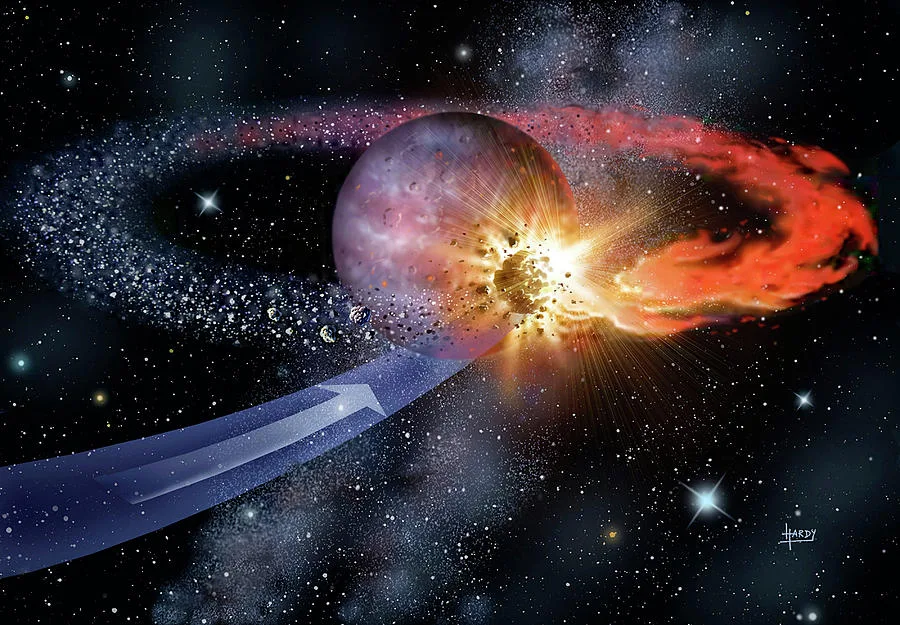
The Giant Impact Hypothesis, also known as the Theia Impact or the Big Whack, is a widely accepted scientific explanation for the formation of the Moon. It proposes that the Moon was created as a result of a massive collision between Earth and a Mars-sized protoplanet called Theia, early in the history of the solar system.
Conditions Leading to the Proposed Collision:
The scenario leading to the giant impact is thought to have occurred around 4.5 billion years ago, during a period known as the Late Heavy Bombardment. The key conditions leading to this proposed collision include:
- Early Solar System Dynamics: In the early stages of the solar system, numerous protoplanets and planetesimals orbited the Sun. The gravitational interactions and migrations of these bodies set the stage for potential collisions.
- Formation of Theia: Theia, the hypothetical protoplanet involved in the collision, is believed to have formed in a similar region of the solar system as Earth. Its name is derived from Greek mythology, where Theia was a Titan and the mother of the Moon goddess Selene.
- Orbital Dynamics: Theia’s orbit is thought to have eventually become destabilized, leading it on a collision course with Earth. The specifics of this orbital instability are complex and involve gravitational interactions with other bodies in the early solar system.
- Collision: The collision itself was an incredibly energetic event. Theia collided with the young Earth at a high velocity, releasing an immense amount of energy. The impact led to the ejection of debris, which eventually coalesced to form the Moon.
Simulation Models Supporting the Hypothesis:
Numerical simulations and modeling have played a crucial role in supporting the Giant Impact Hypothesis. These simulations take into account the laws of physics, including gravitational interactions, material properties, and the dynamics of celestial bodies. Here are some key points supported by simulation models:
- Debris Formation: Simulations show that the collision between Earth and Theia would have generated a significant amount of debris. This debris was then expected to form a disk of molten material around Earth.
- Moon Formation: The debris in the accretion disk gradually came together to form the Moon. This process, called accretion, involved the gravitational attraction and merging of countless small particles into larger bodies.
- Angular Momentum Conservation: The simulations explain how angular momentum is conserved in the system. The rotation of the Earth-Moon system is a key outcome of the collision, and the models show how the final configuration of the Earth-Moon system reflects the conservation of angular momentum.
- Isotope Ratios: The chemical composition of the Moon is found to be similar to Earth’s mantle, supporting the idea that the Moon originated from Earth. However, the Moon has a lower iron content, consistent with the expectation that the impacting body (Theia) contributed to the Moon’s formation.
In summary, the Giant Impact Hypothesis provides a compelling explanation for the origin of the Moon, and numerical simulations offer support by demonstrating how the collision between Earth and Theia could have led to the formation of our planet’s natural satellite. These simulations help scientists understand the dynamics of early solar system events and the processes that shaped the terrestrial planets.
Pre-collision Earth: Earth’s Early Conditions and Composition
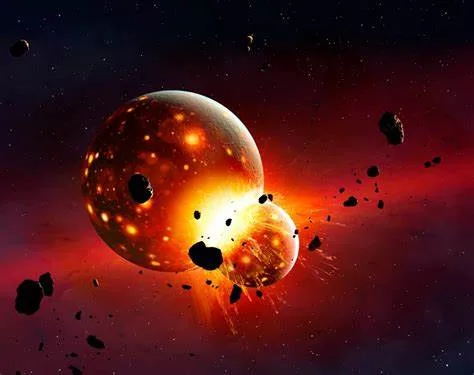
Understanding the conditions of pre-collision Earth is crucial for comprehending the dynamics that led to the formation of the Moon. Around 4.5 billion years ago, during the early stages of the solar system, Earth was undergoing a series of transformative processes. Here are key aspects of Earth’s early conditions and composition:
- Formation: Earth formed through accretion, a process in which smaller planetesimals and protoplanets collided and merged to create a larger body. This process led to the differentiation of Earth’s interior into distinct layers, with heavy metals like iron and nickel sinking to the core, and lighter materials forming the mantle and crust.
- Molten State: In its early stages, Earth was predominantly molten due to the heat generated during the accretion process and the energy released by the decay of radioactive isotopes. This molten state allowed for the segregation of materials based on density.
- Atmosphere and Hydrosphere: Earth’s early atmosphere was likely composed of volatile compounds like water vapor, carbon dioxide, methane, and ammonia. The presence of water vapor eventually condensed, leading to the formation of Earth’s primitive oceans and the beginning of the hydrosphere.
- Heavy Bombardment: During the Late Heavy Bombardment period, which occurred roughly 4.1 to 3.8 billion years ago, Earth experienced intense impacts from leftover planetesimals and protoplanets. These impacts played a significant role in shaping the early Earth and may have contributed to the eventual formation of the Moon.
Proto-Moon or Pre-existing Celestial Bodies:
The question of whether Earth had a proto-Moon or pre-existing celestial bodies before the giant impact is a topic of scientific investigation. Some models propose the existence of a small moon or moonlets in orbit around Earth prior to the giant impact. Here are a few considerations:
- Co-formation Hypothesis: Some models suggest that the Moon formed alongside Earth during the accretion process. According to this co-formation hypothesis, a series of smaller moonlets or proto-Moons may have coalesced to form a larger Moon. These moonlets could have been remnants of the material from which Earth itself was forming.
- Capture Hypothesis: Another hypothesis proposes that the Moon was captured by Earth’s gravity from its original orbit around the Sun. However, the likelihood of such a capture is considered to be low, as it would require specific conditions that are not commonly found in the solar system.
- Collision and Debris: The prevailing Giant Impact Hypothesis suggests that the Moon formed from the debris ejected during a collision between Earth and a Mars-sized protoplanet (Theia). In this scenario, there was no pre-existing Moon, and the collision itself led to the creation of the Moon from the resulting debris disk.
While the precise details of Earth’s early conditions and the presence of a proto-Moon or pre-existing celestial bodies are still areas of active research, the Giant Impact Hypothesis remains the most widely accepted explanation for the Moon’s formation. This hypothesis provides a coherent and well-supported narrative for the events that led to the creation of Earth’s natural satellite.
The Impact Event: Collision Between Earth and the Impactor
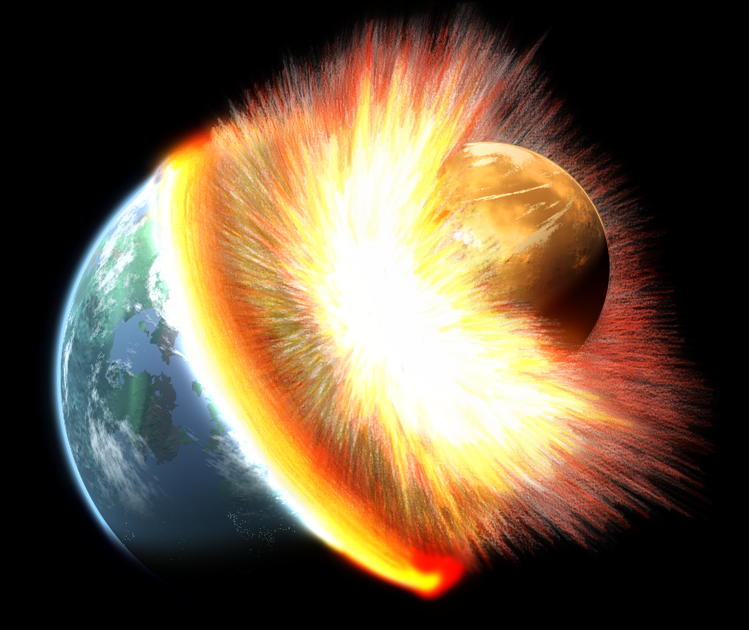
The impact event that led to the formation of the Moon was an incredibly violent and energetic collision between Earth and a Mars-sized protoplanet called Theia. Here’s a description of the key stages of the impact:
- Approach and Orbital Dynamics: Theia, on a collision course with Earth, approached our planet at a high velocity. The specifics of the collision were influenced by the orbital dynamics of both bodies, with gravitational forces playing a significant role in determining the trajectory and energy of the impact.
- Contact: As Theia collided with Earth, an immense amount of energy was released. The impact would have been so powerful that it led to the deformation and disruption of both the impacting body and Earth’s surface.
- Ejection of Debris: The impact resulted in the ejection of a large amount of debris from both Earth and Theia. This debris was propelled into space, forming an accretion disk around Earth.
- Accretion Disk Formation: The debris, consisting of molten and vaporized rock, formed a swirling disk of material around Earth. This disk extended into space and gradually coalesced due to gravitational interactions.
Energy Release, Heat, and Formation of a Molten Mass:
The collision between Earth and Theia released an extraordinary amount of energy, transforming a significant portion of the impacted region into a molten mass. Here are key aspects of this process:
- Energy Release: The energy released during the impact was immense, equivalent to a staggering amount of kinetic and gravitational potential energy being converted into heat. This energy release contributed to the extreme temperatures generated during the collision.
- Heat Generation: The impact generated intense heat due to the conversion of kinetic energy into thermal energy upon collision. The temperatures reached were high enough to melt a substantial portion of Earth’s surface and the impacting body, creating a molten, partially vaporized mass.
- Molten Mass Formation: The heat generated by the impact caused the impacted region to melt and form a molten mass. This molten material, consisting of rock and metal from both Earth and Theia, contributed to the creation of the accretion disk around Earth.
- Accretion of the Moon: Over time, the molten material in the accretion disk began to cool and solidify. Through the process of accretion, small particles within the disk began to clump together, forming larger and larger bodies. Ultimately, these processes led to the coalescence of material into the Moon.
The aftermath of the impact event resulted in the formation of the Moon and marked a critical phase in the early history of both Earth and the Moon. The debris ejected into space eventually came together to create the Moon, and the energy released during the collision played a fundamental role in shaping the characteristics of Earth’s natural satellite.
Formation of a Proto-Lunar Disk

The formation of a proto-lunar disk was a crucial step in the process that eventually led to the creation of the Moon. This disk formed as a result of the immense energy released during the collision between Earth and the impactor, Theia. Here’s a detailed explanation of how the debris and materials ejected into space contributed to the formation of a disk around Earth:
- Ejection of Debris:
- The high-velocity impact between Earth and Theia resulted in the violent ejection of a significant amount of material from both bodies.
- This ejected material consisted of molten rock, vaporized substances, and fragments from the impacting bodies. The composition included elements from Earth’s mantle, crust, and Theia.
- Formation of an Accretion Disk:
- The ejected material did not escape Earth’s gravitational influence completely. Instead, it formed a swirling disk of debris in orbit around Earth.
- The gravitational forces acting on the debris caused it to spread out and take the form of a disk-shaped structure encircling Earth.
- Proto-Lunar Disk Composition:
- The proto-lunar disk was composed of molten and vaporized rock, as well as other materials that were present in the colliding bodies.
- The intense heat generated by the impact kept the material in the disk in a molten or partially vaporized state.
- Angular Momentum Conservation:
- The conservation of angular momentum played a crucial role in the formation of the proto-lunar disk. As the impacting body and Earth collided, their combined angular momentum influenced the motion of the debris.
- This conservation principle led to the rotation of the proto-lunar disk in the same direction as Earth’s rotation.
- Accretion and Moon Formation:
- Within the proto-lunar disk, small particles began to accrete and collide due to gravitational attraction. This process led to the formation of larger and larger bodies within the disk.
- Over time, these accreted bodies merged to form protomoonlets and, eventually, the Moon itself. The gradual coalescence of material within the disk resulted in the solidification of the Moon as it grew in size.
- Orbital Dynamics:
- The proto-lunar disk influenced the orbital dynamics of the system. As the Moon formed within the disk, it interacted with the surrounding material and adjusted its orbit over time.
The formation of the proto-lunar disk represents a critical phase in the Giant Impact Hypothesis, providing a mechanism for the creation of the Moon from the debris ejected during the collision. This swirling disk of molten material, shaped by gravitational forces and angular momentum conservation, laid the foundation for the subsequent accretion and consolidation of material into Earth’s natural satellite.
Accretion of the Moon

The accretion of the Moon involved the gradual coming together and merging of smaller bodies within the proto-lunar disk, driven by gravitational forces. As these bodies accreted, they formed larger and larger structures until the Moon took shape. Here’s a detailed explanation of the accretion process and the subsequent cooling and solidification of the Moon:
1. Gravitational Forces and Accretion:
- Within the proto-lunar disk, individual particles, protomoonlets, and smaller bodies experienced gravitational attraction toward one another.
- Gravitational forces caused these particles to come together, forming larger aggregates. As these aggregates grew, their gravitational pull increased, facilitating the accretion of more material.
2. Formation of Protomoonlets:
- Initially, small protomoonlets formed as a result of the accretion process. These were intermediate-sized bodies that continued to grow by attracting additional material within the disk.
3. Collisions and Growth:
- Larger bodies within the proto-lunar disk collided with one another, leading to the formation of even larger structures.
- Over time, the process of collisions and accretion resulted in the development of protomoonlets of substantial size.
4. Continued Accretion:
- Gravitational interactions persisted, causing protomoonlets to attract more material and merge with neighboring bodies.
- The largest of these protomoonlets exerted stronger gravitational influence, leading to their dominance in the ongoing accretion process.
5. Moon Formation:
- As the accretion continued, one dominant body emerged, gradually accumulating most of the material within the proto-lunar disk.
- This dominant body evolved into the Moon, representing the culmination of the accretion process.
6. Cooling and Solidification:
- As the Moon formed and grew in size, the heat generated during the accretion process began to dissipate.
- The cooling of the Moon occurred as the heat was radiated away into space. This cooling process led to the solidification of the Moon’s surface and interior.
7. Differentiation:
- The cooling and solidification of the Moon allowed for the differentiation of its interior. Heavier materials sank toward the Moon’s core, while lighter materials rose to the surface, a process similar to the early differentiation of Earth.
8. Final Configuration:
- Over a considerable period, the Moon reached its final configuration as a solid, differentiated body with a surface composed of solidified rock.
- The Moon’s rotation became tidally locked with Earth, meaning it always shows the same face to our planet.
The accretion of the Moon was a dynamic process influenced by gravitational interactions, angular momentum conservation, and the orbital dynamics within the proto-lunar disk. The subsequent cooling and solidification of the Moon resulted in the formation of the lunar surface and the establishment of the Moon as Earth’s natural satellite.
Composition of the Moon
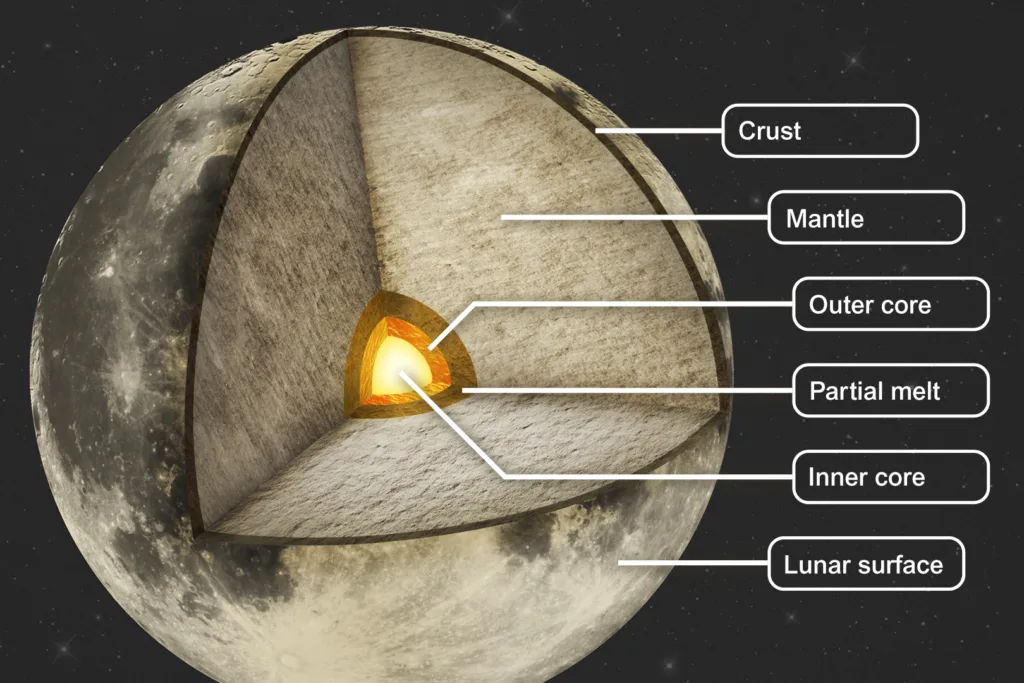
The Moon is composed of various materials that provide insights into its formation and evolution. The primary components of the Moon’s composition include:
- Crust:
- The lunar crust is predominantly composed of rocks rich in aluminum and silica, known as anorthosite. Anorthosite is formed from the solidification of molten material during the Moon’s early history.
- Mantle:
- Core:
- Unlike Earth, the Moon does not have a large, liquid outer core. Instead, any metallic core is thought to be small and partially solidified, primarily composed of iron and nickel.
- Surface Features:
- The Moon’s surface is marked by various features, including impact craters, lunar maria (large, dark plains formed by ancient volcanic activity), mountains, and valleys. These features result from a combination of volcanic activity, impact events, and the Moon’s geological history.
- Regolith:
- The lunar regolith is a layer of loose, fragmented material that covers the Moon’s surface. It consists of fine-grained particles produced by the continual bombardment of the Moon by micrometeoroids and larger impactors.
- Water Ice:
- Recent discoveries suggest the presence of water ice in permanently shadowed regions near the lunar poles. This finding has implications for future lunar exploration and potential resource utilization.
Differentiation of Materials within the Moon:
The Moon’s composition and structure exhibit signs of differentiation, a process that involves the separation and sinking of denser materials toward the center, while lighter materials rise to the surface. Here’s an overview of the differentiation of materials within the Moon:
- Early Differentiation:
- During the Moon’s early history, when it was in a molten or partially molten state, differentiation began. Heavier materials, such as iron and nickel, sank toward the lunar core, while lighter materials, like aluminum and silica, rose to form the crust.
- Crustal Formation:
- The solidification of the lunar magma ocean led to the formation of the anorthositic crust. Anorthosite rocks, rich in aluminum and silica, represent the primary components of the lunar crust.
- Mantle Composition:
- The lunar mantle, lying beneath the crust, is composed of denser rocks like pyroxene and olivine. These materials are remnants from the early differentiation process and provide insight into the Moon’s internal structure.
- Limited Core Differentiation:
- While the Moon is thought to have a small metallic core, it is not as extensively differentiated as Earth’s core. The Moon’s core likely contains a mixture of iron and nickel, and it may be partially solidified.
- Surface Features and Impact History:
- The Moon’s surface features, including impact craters and lunar maria, are the result of subsequent geological processes that have shaped the lunar landscape. Impact events have played a significant role in modifying the Moon’s surface over time.
Understanding the composition and differentiation of the Moon’s materials provides valuable information about the early solar system, the Moon’s formation, and the processes that shaped terrestrial bodies in our cosmic neighborhood. Ongoing scientific exploration and study of lunar samples contribute to refining our understanding of the Moon’s complex history.
Evidence Supporting the Giant Impact Hypothesis
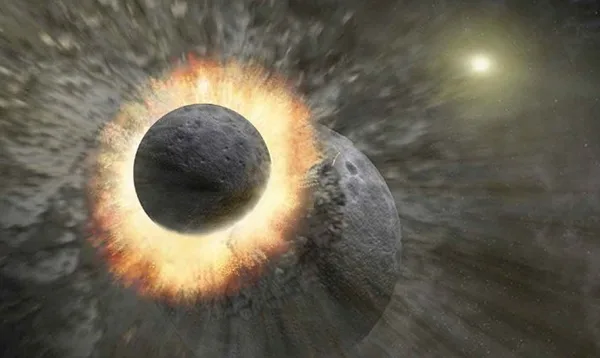
The Giant Impact Hypothesis, which proposes that the Moon formed as a result of a massive collision between Earth and a Mars-sized protoplanet (Theia), is supported by various lines of evidence, including Moon rock samples, isotopic ratios, and orbital characteristics. Here’s an overview of these supporting pieces of evidence:
- Moon Rock Samples and Similarities to Earth’s Crust:
- The analysis of lunar rock samples brought back by the Apollo missions reveals striking similarities between the composition of the Moon’s crust and Earth’s crust.
- Both the Moon’s anorthositic crust and Earth’s crust are rich in aluminum and silica, specifically in the form of anorthosite rocks. This similarity supports the idea that the Moon formed from material that originated on Earth.
- Isotopic Ratios Consistent with the Impact Scenario:
- Isotopic analysis of Moon rock samples has provided crucial evidence supporting the Giant Impact Hypothesis.
- The isotopic ratios of oxygen, titanium, and other elements in lunar rocks closely match those found in Earth’s mantle, indicating a connection between the Moon and Earth’s composition.
- The similarity in isotopic ratios supports the idea that the Moon’s material originated from both Earth and the impacting body (Theia).
- Angular Momentum Conservation and Orbital Characteristics:
- The Giant Impact Hypothesis predicts certain characteristics of the Earth-Moon system that align with observations.
- The conservation of angular momentum during the impact event is reflected in the current orbital characteristics of the Moon, including its rotation period and its synchronous rotation with Earth. This alignment supports the hypothesis that the Moon formed from the debris ejected during a high-energy impact.
- Simulation Models:
- Numerical simulations and modeling of the collision between Earth and Theia provide additional support for the Giant Impact Hypothesis.
- These simulations demonstrate how the impact could have led to the ejection of debris, the formation of an accretion disk, and the subsequent coalescence of material into the Moon.
- Moon’s Lack of Significant Iron Core:
- The Moon’s relatively small or non-existent iron core is consistent with the Giant Impact Hypothesis. The impacting body, Theia, may have contributed little to no iron to the forming Moon, explaining the Moon’s composition.
- Lunar Maria Formation:
- The lunar maria, large plains on the Moon’s surface, are thought to have formed from volcanic activity that occurred after the giant impact.
- This volcanic activity is consistent with the presence of a molten state during the Moon’s early history, as predicted by the Giant Impact Hypothesis.
In summary, the Giant Impact Hypothesis is supported by a convergence of evidence, including the composition of Moon rock samples, isotopic ratios, orbital characteristics, and the results of numerical simulations. The consistent findings from multiple lines of inquiry strengthen the scientific consensus regarding the Moon’s formation through a colossal collision event in the early history of our solar system.
Alternative Theories
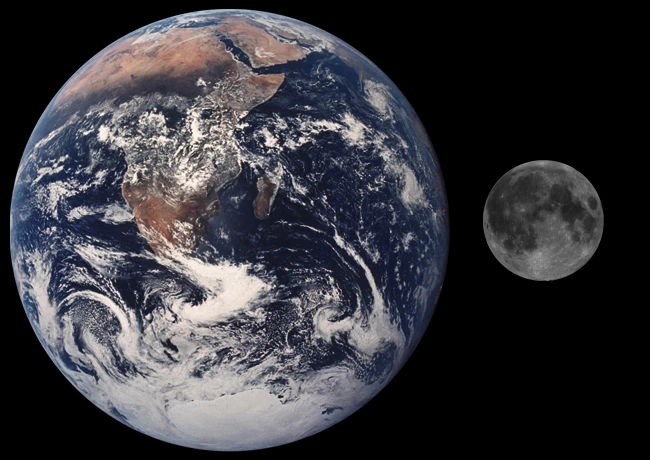
While the Giant Impact Hypothesis is widely accepted as the leading explanation for the Moon’s formation, alternative theories have been proposed. Here are a couple of alternative theories, along with a brief comparison of their strengths and weaknesses:
- Double Planet Hypothesis:
- The Double Planet Hypothesis suggests that the Moon formed as a result of the gravitational capture of a celestial body that was passing by Earth. This passing body would have been captured into orbit around Earth, eventually becoming the Moon.
- Strengths:
- It doesn’t rely on a massive collision, potentially avoiding some of the challenges associated with the energy requirements of the Giant Impact Hypothesis.
- Weaknesses:
- The mechanics of gravitational capture are complex, and it is challenging for a celestial body to be captured into a stable orbit around Earth without a significant energy transfer. This hypothesis faces challenges in explaining the observed isotopic similarities between the Moon and Earth.
- Fission Hypothesis:
- The Fission Hypothesis suggests that the Moon was once part of Earth and was separated from it early in the planet’s history. This separation could have been caused by the rapid rotation of a young Earth, leading to material being ejected and forming the Moon.
- Strengths:
- It accounts for the isotopic similarities between the Moon and Earth.
- The hypothesis doesn’t require an external impacting body.
- Weaknesses:
- The energy required to separate a portion of Earth and form the Moon through fission is considered to be impractical.
- It is challenging to explain the current angular momentum and orbital characteristics of the Earth-Moon system using this hypothesis.
Comparison of Strengths and Weaknesses:
- Giant Impact Hypothesis:
- Strengths:
- Consistent with the observed isotopic similarities between the Moon and Earth.
- Explains the angular momentum and orbital characteristics of the Earth-Moon system.
- Supported by numerical simulations.
- Weaknesses:
- Challenges related to the energy requirements of the impact event.
- Strengths:
- Double Planet Hypothesis:
- Strengths:
- Doesn’t rely on a massive collision.
- Weaknesses:
- Faces challenges in explaining isotopic similarities.
- Complex mechanics of gravitational capture.
- Strengths:
- Fission Hypothesis:
- Strengths:
- Accounts for isotopic similarities.
- Doesn’t require an external impacting body.
- Weaknesses:
- Impractical energy requirements for the fission process.
- Challenges in explaining current angular momentum and orbital characteristics.
- Strengths:
In summary, each hypothesis has its strengths and weaknesses. The Giant Impact Hypothesis remains the most widely accepted due to its ability to account for multiple lines of evidence, including isotopic similarities and orbital characteristics. However, ongoing research and advances in planetary science may lead to further refinement or new theories regarding the Moon’s formation.
Post-Formation Evolution
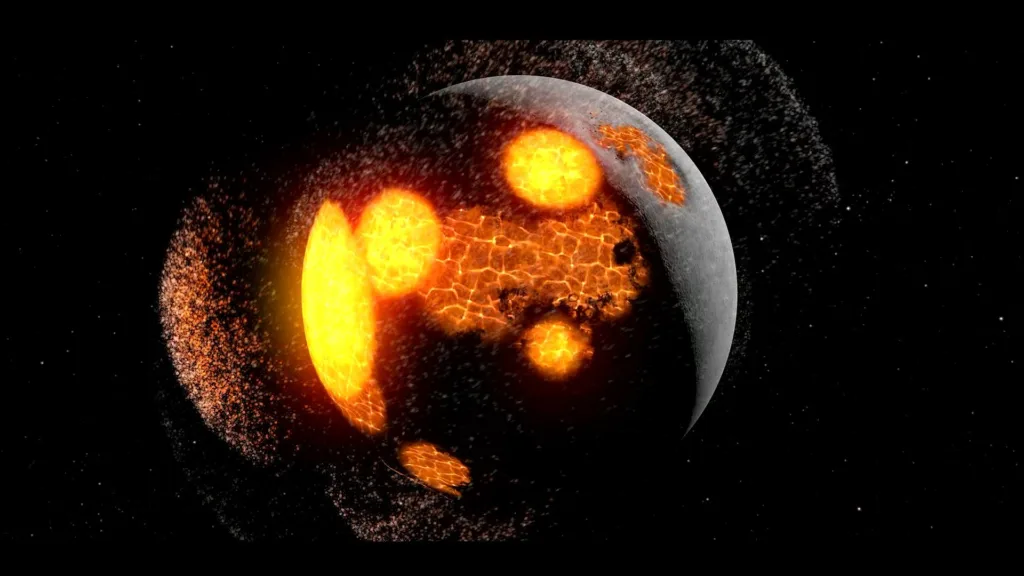
The post-formation evolution of the Moon is characterized by a complex interplay of geological processes that have shaped its surface and interior. Here’s an overview of the early history of the Moon, including impact cratering, volcanic activity, and other significant geological processes:
1. Early Bombardment (4.5 to 3.8 billion years ago):
- The Moon’s early history was marked by a period of intense bombardment known as the Late Heavy Bombardment (LHB). During this time, the Moon, along with other bodies in the solar system, experienced a high frequency of impact events from leftover planetesimals and asteroids.
2. Formation of Impact Basins:
- Large impact events during the early bombardment created basins, some of which later became filled with lava, forming lunar maria. Notable impact basins include Imbrium, Serenitatis, Crisium, and others.
3. Lunar Maria Formation (3.8 to 3.2 billion years ago):
- The lunar maria are large, dark plains on the Moon’s surface. These areas were formed by volcanic activity that occurred after the early bombardment. Lava flows filled the impact basins, creating the smooth, dark regions visible on the Moon.
4. Decline in Volcanic Activity:
- The Moon’s volcanic activity declined over time, and the most recent volcanic activity is thought to have occurred around 1 billion years ago. The decline may be related to the Moon’s cooling interior and decreasing availability of molten material.
5. Regolith Formation:
- The continuous bombardment of the Moon’s surface by micrometeoroids and larger impactors over billions of years has created a layer of loose, fragmented material known as regolith. This layer covers much of the lunar surface and is several meters thick in some areas.
6. Tidal Evolution:
- The gravitational interactions between the Moon and Earth have led to tidal forces that influenced the Moon’s rotation. As a result, the same face of the Moon always points toward Earth in a phenomenon known as synchronous rotation.
7. Seismic Activity:
- While the Moon is not tectonically active like Earth, it does experience moonquakes. These quakes are thought to be caused by the gravitational interactions with Earth, the cooling and contraction of the Moon’s interior, or the stress induced by impacts.
8. Surface Weathering:
- The Moon’s lack of atmosphere means that it is not subject to weathering processes like wind and water erosion. However, micrometeoroid impacts and the solar wind have contributed to a form of “space weathering,” altering the surface properties over time.
9. Recent Geological Activity (Possible):
- Recent discoveries, including observations of transient lunar phenomena and hints of potential volcanic activity, have raised questions about the possibility of more recent geological processes. However, further research is needed to confirm the nature and extent of any recent lunar activity.
In summary, the Moon’s early history was shaped by intense bombardment during the Late Heavy Bombardment, followed by the formation of impact basins and volcanic activity that created the lunar maria. Over time, the Moon’s geological activity declined, and its surface was further modified by ongoing impact cratering and the accumulation of regolith. Studying the Moon’s geological history provides valuable insights into the early solar system and the processes that shaped rocky bodies in our cosmic neighborhood.
Conclusion: Recap of key points in the Moon’s formation
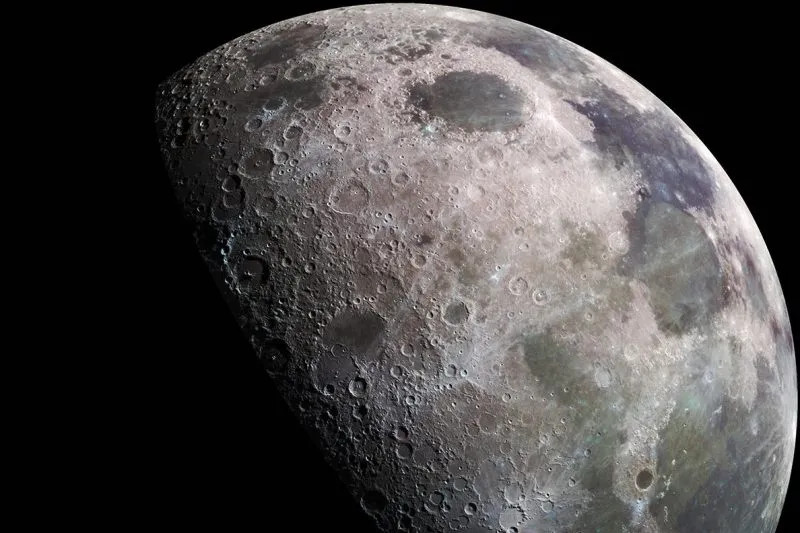
In conclusion, the formation of the Moon is intricately tied to the Giant Impact Hypothesis, which proposes that a massive collision between Earth and a Mars-sized protoplanet, Theia, led to the creation of our natural satellite. Key points in the Moon’s formation include:
- Giant Impact Hypothesis: The Moon formed approximately 4.5 billion years ago as a result of a colossal collision between Earth and Theia. The impact led to the ejection of debris, the formation of an accretion disk, and the gradual coalescence of material into the Moon.
- Composition and Isotopic Similarities: Moon rock samples collected during the Apollo missions exhibit a composition similar to Earth’s crust, supporting the hypothesis that the Moon originated from both Earth and Theia. Isotopic ratios further confirm these similarities.
- Accretion and Differentiation: The accretion of material within the proto-lunar disk, driven by gravitational forces, led to the differentiation of the Moon’s interior. The Moon’s crust, mantle, and limited core reflect the processes of early solar system evolution.
- Post-Formation Evolution: The Moon’s early history was marked by intense bombardment during the Late Heavy Bombardment, the formation of impact basins, and volcanic activity that created the lunar maria. Ongoing geological processes, such as regolith formation and tidal evolution, continue to shape the lunar surface.
- Scientific Interest and Exploration: The Moon remains a focal point for scientific interest and exploration. Ongoing missions, including robotic landers, orbiters, and potential crewed missions, aim to uncover new insights into lunar geology, the Moon’s history, and its potential as a platform for further space exploration.
The Moon serves as a natural laboratory for studying planetary processes, the early solar system, and the dynamics that have shaped rocky bodies in our cosmic neighborhood. Continued scientific exploration, including planned lunar missions and potential human presence, holds the promise of unraveling more mysteries about the Moon’s formation and evolution, as well as its significance in the broader context of space exploration and understanding our solar system.



























